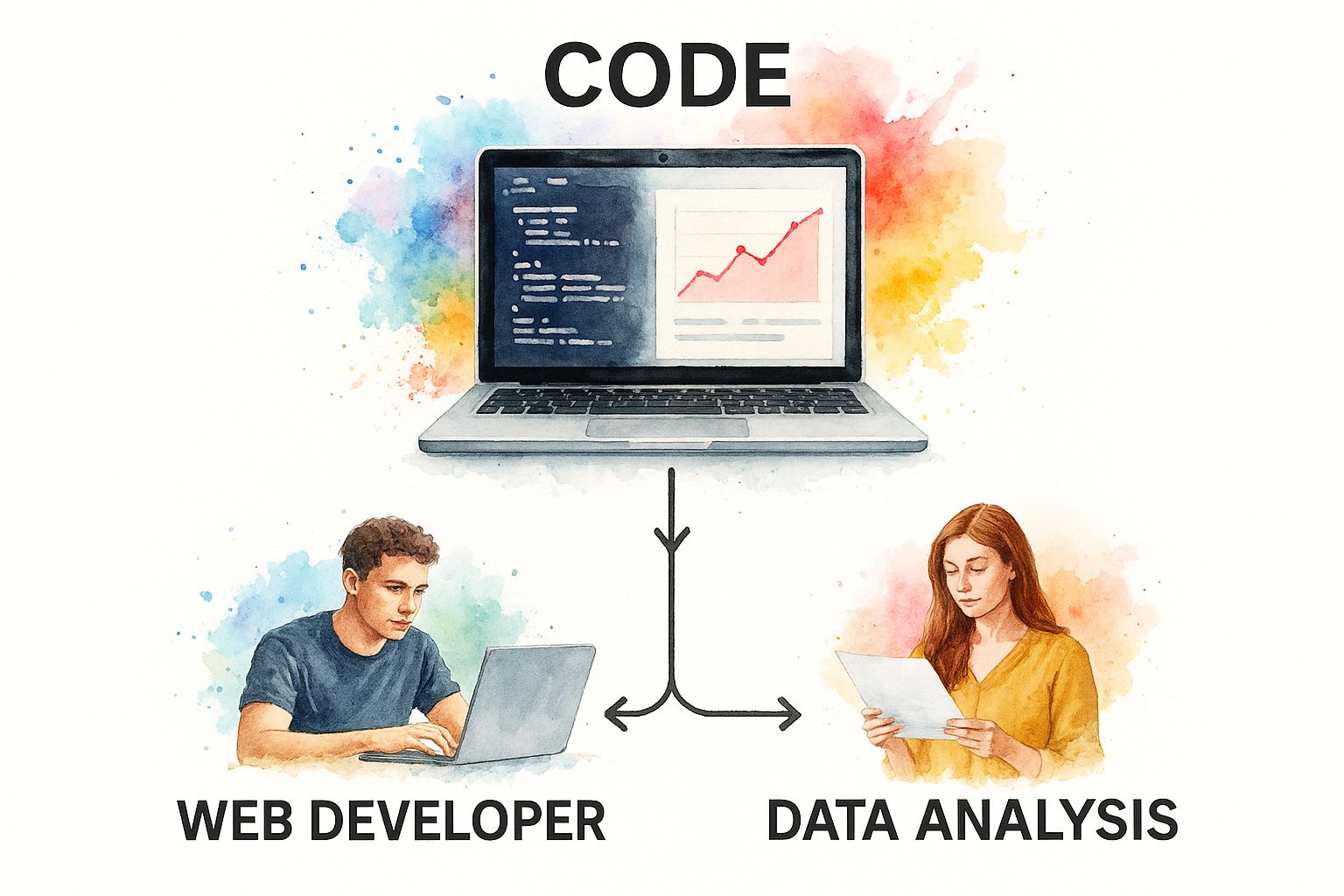Data Analyst Job Requirements: Your Guide to Success
Max
So, you’re thinking about becoming a data analyst? It’s a fantastic career path, but the job descriptions can sometimes feel like they’re written in a different language. Let’s cut through the noise and talk about what it really takes to land a great role.
At its heart, a data analyst’s job is to be a detective for the business. You’re given clues (data), and you use your specialized gear (tools like SQL and Python) to piece together a story. The final step? You present your findings to company leaders, giving them the clear, actionable insights they need to make smarter decisions.
This isn’t just about being a number-cruncher. Anyone can report that sales are down. A great data analyst digs deeper to figure out why. They connect the dots between raw numbers and real-world events, like a recent marketing campaign or a shift in customer behavior.
The Core Pillars of a Data Analyst Job
To get hired as a data analyst, you need to build a strong foundation in a few key areas. Think of these as the pillars holding up your career. Hiring managers will be looking for evidence of all three.
- Technical Chops: You absolutely need the right tools in your toolkit. This means knowing your way around databases to pull data, using programming languages to clean and shape it, and wielding visualization software to bring the story to life.
- An Analytical Mind: This goes way beyond math class. It’s about having a deep-seated curiosity, a knack for structured problem-solving, and the ability to think critically about what the data is actually saying, not just what it seems to say on the surface.
- Business Acumen: This is the secret sauce. You have to understand what the business is trying to achieve. Your analysis is only valuable if it connects directly to a business goal, whether that’s boosting revenue, cutting costs, or making customers happier.
Before we dive into the specifics of each pillar, here’s a quick overview of what employers are looking for.
Core Data Analyst Job Requirements at a Glance
This table summarizes the essential components hiring managers look for in data analyst candidates. We’ll explore each of these in much more detail in the sections below.
| Requirement Pillar | What It Means for You |
|---|---|
| Education | A bachelor’s degree in a quantitative field is common, but not always required if you have strong skills. |
| Technical Skills | Proficiency in SQL, Excel, and at least one BI tool (like Tableau or Power BI) is non-negotiable. |
| Soft Skills | Excellent communication, critical thinking, and problem-solving abilities are essential. |
| Certifications | Industry-recognized certifications can validate your skills and help you stand out. |
| Experience | A portfolio of real-world projects is crucial for demonstrating your capabilities. |
Getting these pillars right is more than just a good idea—it’s your ticket into a booming field. The U.S. Bureau of Labor Statistics projects that jobs for data analysts will grow by an incredible 36% by 2033. That’s way faster than the average for most other professions.
A successful data analyst is a translator—someone who can speak the language of data to computers and the language of business to people. Your value lies in bridging that gap.
If you’re just starting, it’s all about building that foundation. You can explore different learning paths to find what works best for you, whether it’s a formal degree, a bootcamp, or self-study. As you build your skills, it’s also a great idea to start browsing real-world job postings on sites like https://remotefirstjobs.com/remote-data-jobs to see how these requirements show up in the wild.
Mastering the Data Analyst Technical Toolkit
If an analyst’s mind is the engine, then their technical toolkit is the high-performance vehicle that gets them from raw data to breakthrough insights. Let’s be clear: getting a job as a data analyst means getting fluent with specific technologies. These aren’t just buzzwords to pad your resume; they are the actual tools of the trade you’ll use every single day.
The Foundation: SQL
Think of a company’s data as being stored in a massive, highly organized library. To find anything, you can’t just wander in and browse the shelves. You need to speak the library’s native language, and for databases, that language is SQL (Structured Query Language).
SQL is the universal key that unlocks information. It’s how you talk directly to databases, asking precise questions to pull the exact information you need. Whether you’re grabbing sales figures from last quarter or trying to isolate user activity on a single webpage, SQL is the non-negotiable starting point for almost any analysis.
The Analyst’s Workshop: Python and R
Once you’ve used SQL to get your raw materials, you need a workshop to clean, shape, and really dig into them. This is where programming languages like Python and R come in. Think of these languages as the ultimate multi-tools, packed with powerful libraries for every step of the analytical journey.
With them, you can:
- Clean Data: Handle messy data by fixing errors, filling in missing values, and standardizing formats to make sure your analysis is built on a reliable foundation.
- Transform Data: Create new features from existing data, roll up information into summaries, or completely restructure it to get it ready for modeling.
- Run Statistical Analysis: Perform complex statistical tests and build predictive models that uncover the deeper patterns hidden in the noise.
While Python’s incredible versatility has made it a favorite across the industry, R is still a heavyweight, especially in academic and research circles. Being proficient in at least one of these is now a standard expectation for any serious analyst.
The skill requirements for data analysts are definitely getting more technical and specialized, which reflects just how much the profession has grown. As of mid-2025, the average base salary for a data analyst in the United States sits around $74,052, a number that’s heavily influenced by how deep your technical expertise goes in SQL, programming, and data management. You can learn more about the evolution of data analyst careers on Coursera.
The image below gives you a great visual of how all these technical skills fit together in a typical data analyst’s workflow.

As you can see, foundational database skills are the bedrock. They support the entire structure, paving the way for the more advanced analysis and visualization that ultimately deliver real business value.
Data Analyst Tool Proficiency Breakdown
To give you a clearer picture, let’s break down the essential tools data analysts rely on. The table below organizes them by their main job in the analytics process, showing what you’ll use and why.
| Tool Category | Key Tools | Primary Use Case |
|---|---|---|
| Database Querying | SQL (various dialects like PostgreSQL, MySQL) | Extracting, filtering, and retrieving data directly from relational databases. |
| Programming/Statistics | Python (with Pandas, NumPy), R | In-depth data manipulation, statistical modeling, and machine learning tasks. |
| Spreadsheet Software | Microsoft Excel, Google Sheets | Quick ad-hoc analysis, creating simple charts, and data entry. |
| Data Visualization | Tableau, Power BI, Looker Studio | Creating interactive dashboards and compelling visual stories to share insights. |
This breakdown isn’t exhaustive, but it covers the core of what hiring managers are looking for. Mastering the tools in each category makes you a versatile and highly effective analyst, ready to tackle problems from multiple angles.
Don’t Forget Spreadsheet Skills
Even with all the advanced programming languages at your disposal, never underestimate the raw power and speed of spreadsheet tools like Microsoft Excel and Google Sheets. They are still absolutely vital for quick, on-the-fly analysis, whipping up simple charts, and sharing your findings with colleagues who aren’t as tech-savvy.
For so many day-to-day tasks, a well-structured spreadsheet is the fastest path from a question to a clear answer. Mastering functions like VLOOKUP, pivot tables, and basic charting is an essential data analyst job requirement.
Ultimately, your technical toolkit—from the database power of SQL to the analytical depth of Python and the quick-and-dirty utility of Excel—forms the foundation of your capabilities. Each tool has its place, and together, they empower you to turn raw, messy data into a strategic asset for your business.
The Soft Skills That Turn Data into Decisions
Technical abilities might get your resume noticed, but it’s the soft skills that truly close the deal and build a lasting career. While SQL and Python are the tools you use to dig for insights, soft skills are how you translate those insights into action. Without them, even the most brilliant analysis can fall flat, lost in a sea of numbers that non-technical leaders can’t understand or act upon.
Think of it this way: a technical analyst can tell you what happened. A strategically-minded analyst with strong soft skills can tell you why it happened, what it means for the business, and what you should do about it next. This is the difference between simply reporting data and actually driving decisions.

These abilities are a non-negotiable part of data analyst job requirements because they’re the bridge between complex data and business reality.
The Power of Storytelling and Communication
Your main job isn’t just to crunch numbers; it’s to communicate your findings in a way that’s clear, convincing, and compelling. This is where storytelling comes into play. It’s all about weaving your data points into a coherent narrative that connects with your audience on a human level.
A great data story has a beginning (the business problem), a middle (your analysis and key findings), and an end (your recommendation). It simplifies complexity without dumbing down the facts. So instead of just showing a chart with a declining trend line, you explain the context, pinpoint the drivers you discovered, and present a clear path forward.
An analyst who can tell a compelling story with data is more than a technician; they are a trusted advisor. They transform complex findings into a persuasive case for action that executives can confidently support.
Effective communication also means knowing your audience. How you break down findings for the marketing team will be completely different from how you present them to the CEO or a room full of engineers.
Curiosity and Critical Thinking
The best data analysts I’ve ever worked with are fueled by an insatiable curiosity. They don’t just answer the questions they’re given; they start asking the next, more insightful questions the business hasn’t even thought of yet. This proactive approach is what uncovers game-changing opportunities and hidden risks.
This curiosity is powered by critical thinking. It’s the ability to look at a dataset and instinctively question its origins, its biases, and its limitations.
- Questioning Assumptions: “Are we sure this data represents all our customers, or is it skewed toward a specific segment?”
- Identifying Root Causes: “Sales are down, but is it our new pricing, a competitor’s big campaign, or a broader market trend?”
- Seeing the Bigger Picture: “How does this small dip in user engagement affect our long-term customer retention goals?”
These skills are invaluable, and you can bet hiring managers will test for them. A great way to prepare is to practice answering common remote job interview questions that dig into your problem-solving process and communication style. Being able to articulate how you think is just as important as the final answer. These aren’t just “nice-to-haves”—they are the core skills that make an analyst an indispensable strategic partner.
How to Build a Job-Winning Data Portfolio
While your skills are the foundation, a solid data portfolio is the tangible proof that you can actually deliver value. It’s one thing to say you know SQL and Python; it’s another thing entirely to show a hiring manager what you can build with them.
This is your chance to shine, especially if you’re new to the field. For many entry-level and career-changing professionals, the portfolio is the most critical piece of the puzzle when it comes to meeting data analyst job requirements.
Think of your portfolio as a gallery of your best work, not just a resume. Each project is a case study, telling a complete story of how you tackled a problem from start to finish. It’s your opportunity to prove you can think like an analyst.
Sourcing Your Data for Impactful Projects
So, where do you get the data? Luckily, you don’t have to look far. The internet is overflowing with free, high-quality public datasets perfect for building out your first few projects.
Great starting points are platforms like Kaggle and data.gov. They are absolute treasure troves of information on everything from global economic trends and movie box office stats to public health records.
Here’s a quick look at the dataset discovery page on Kaggle.
The best part is the sheer variety. You can pick topics that genuinely interest you, which makes the work more engaging. That passion will come through in your final project and make it that much more compelling.
The most compelling portfolios feature projects that answer a specific, interesting question. Instead of a generic analysis, frame your project around a problem: “Which marketing channel drove the most valuable customers for this fictional e-commerce store?”
Finding a dataset is the first step, but framing the right question is what gives your project a real sense of purpose.
Structuring Your Portfolio Projects for Success
Once you’ve got your data and a question you want to answer, it’s time to structure your project. A well-organized project shows you have a methodical, professional approach—exactly what hiring managers want to see.
For every project you add to your portfolio, follow these key steps:
Define the Business Problem: Kick things off by clearly stating the question you’re trying to solve. For instance, “Analyze customer churn data to identify the key factors that lead to account cancellation.”
Data Sourcing and Cleaning: Briefly explain where you found your data. More importantly, detail the steps you took to clean it up. This shows you understand that real-world data is messy and that you have the skills to whip it into shape.
Exploratory Data Analysis (EDA): This is where you get to show off your analytical chops. Document your process of digging into the data, using stats and visuals to uncover patterns, trends, and interesting relationships.
Key Insights and Visualizations: Present your main findings with clear, effective charts or dashboards. Whether you use Tableau or Power BI, make sure every visual serves a purpose and helps tell your story.
Conclusion and Recommendations: Don’t just stop at the findings. Wrap it all up with a summary and, most importantly, provide actionable recommendations based on your analysis. This final step is what turns a technical exercise into a valuable business asset, proving you can connect the dots between data and strategic decisions.
Navigating the Data Analyst Job Market and Salary
Knowing the skills is one thing, but understanding the professional landscape you’re about to step into is a whole different ball game. The good news? The job market for data analysts isn’t just healthy—it’s booming, which means huge opportunities for candidates with the right skills. This high demand translates directly into competitive pay and a solid career path.
The outlook for data analysts is exceptionally strong. Recent data shows the average entry-level salary has climbed to around $90,000 a year. This jump isn’t random; it’s a direct reflection of how much companies now rely on data to make critical decisions. Some places have become major hubs for this work—for example, New York City alone is home to roughly 26% of all data analyst job postings. You can get a deeper dive into this dynamic job outlook from 365 Data Science.
Understanding Salary Expectations
So, what can you actually expect to earn? It really boils down to a few key things: your years of experience, the industry you’re in, and where you’re located. While the starting salaries are great, your earning potential grows significantly as you climb the ladder.
- Entry-Level Analyst (0-2 years): In this role, you’ll be focused on the fundamentals—think data cleaning, building reports, and supporting the senior analysts on your team.
- Mid-Level Analyst (2-5 years): This is where you start taking on meatier projects. You’ll lead smaller initiatives and might even begin specializing in a niche like marketing or financial analytics.
- Senior Analyst (5+ years): At the senior level, your role shifts. You’ll be mentoring junior analysts, helping to shape the company’s analytical strategy, and presenting your high-impact findings directly to executives.
As you rack up that experience, your paycheck will grow right along with it. It’s not uncommon for senior analysts and analytics managers to pull in salaries well over $130,000.
The Evolving Role of a Data Analyst
The job itself is also in a constant state of flux. The rise of AI and automation is actively reshaping what companies are looking for. Mentions of machine learning in job descriptions have doubled to 14%, which sends a pretty clear signal. Analysts who can use AI tools to automate the grunt work and dig for deeper insights are the ones who will be most in demand.
The future of data analytics isn’t about being replaced by AI; it’s about partnering with it. The most successful analysts will be those who can use automation to focus on what humans do best: strategic thinking, creative problem-solving, and telling a compelling story with data.
This evolution means you can never stop learning. To stay ahead of the curve, you have to be proactive about building skills in new and emerging areas.
And as you get ready to jump into this dynamic market, it’s smart to learn the best way to find remote jobs, since so many of these modern roles offer the flexibility to work from anywhere. For more practical advice on making your job hunt faster and more effective, check out these expert tips to speed up your job search.
Your Questions About Data Analyst Careers Answered
Stepping into the world of data analysis can feel a bit like navigating a new city—exciting, but you’ve probably got a few questions. Let’s clear up some of the most common ones to help you map out your journey.
Do I Need a Specific Degree?
Not like you used to. While plenty of analysts come from statistics, math, or computer science backgrounds, that’s not the only path anymore. These days, a lot of employers care more about what you can do than what your diploma says.
A killer portfolio that shows off your real-world projects—using tools like SQL and Python to clean, analyze, and visualize data—can speak much louder than a specific degree. It’s all about proving you have the skills.
What Is the Most Important Entry-Level Skill?
If you had to pick just one skill to nail down first, make it SQL. Seriously. The power to pull, sort, and manage data from databases is the absolute bedrock of almost any analyst job.
It’s often the first thing you’ll do in the morning and the last thing you’ll do at the end of the day. That’s why it’s a non-negotiable part of the core data analyst job requirements.
You need both technical and soft skills, but they serve different purposes. Technical skills prove you can do the work. Soft skills, like communication and problem-solving, prove you can drive real change with your findings.
How Can I Get Experience?
You don’t wait for it—you create it. The best way to get started is by building your own projects. Dive into public datasets on sites like Kaggle or data.gov and find something that genuinely interests you.
From there, it’s a three-step process: define a clear problem you want to solve, document every step of your work (from data cleaning to final analysis), and then visualize your findings. This hands-on work is exactly the kind of tangible proof employers want to see.
Once you feel ready to put those skills to the test, you can find plenty of remote entry-level jobs that are perfect for launching your career. Being proactive like this is the single best way to close the gap between learning the theory and landing your first role.
Ready to find your next opportunity? Remote First Jobs lists thousands of verified, spam-free remote positions to kickstart your career. Find your ideal role today at https://remotefirstjobs.com.


